Modeling and Subjective Evaluation Method of Driveability for Fuel Cell Vehicles
Abstract
1. Introduction
2. Methods
3. Real-Time Model of Fuel Cell Vehicle Powertrain System
3.1. Fuel Cell Model
3.2. Power Battery Model
3.3. Drive Motor Model
3.4. DC/DC Converter Model
4. Virtual Subjective Evaluation Platform for Fuel Cell Vehicles
4.1. Integration of Fuel Cell Vehicle Dynamics Model
4.2. Evaluation Platform of Driveability for Fuel Cell Vehicles
5. Subjective Evaluation Method of Driveability for Fuel Cell Vehicles
5.1. Starting Performance
5.2. Acceleration Performance
- (1)
- Accelerating to 100 km/h at the full accelerator pedal pressing: the driver will step down the accelerator pedal to the bottom to accelerate the fuel cell vehicle from a standstill to 100 km/h.
- (2)
- Interval acceleration at full accelerator pedal pressing: when the accelerator pedal opening is 100%, the driver accelerates in the following speed ranges: 20–60 km/h, 40–80 km/h, 60–100 km/h and 80–120 km/h.
- (3)
- Sudden accelerator pedal pressing: the initial speed is 40 km/h, 60 km/h and 80 km/h. This is followed by sudden acceleration with 30%, 50% and 80% accelerator pedal opening.
- (4)
- Slow accelerator pedal pressing: the initial speed is 40 km/h, 60 km/h and 80 km/h. This is followed by pressing the accelerator to the bottom for about 3 s, 6 s and 9 s, respectively, to accelerate.
5.3. Uniform Speed Performance
5.4. Tip-In/Tip-Out Performance
6. Results and Discussion
6.1. Starting Performance Results and Analysis
6.2. Acceleration Performance Results and Analysis
6.3. Uniform Speed Performance Results and Analysis
6.4. Tip-In/Tip-Out Performance Results and Analysis
7. Conclusions
- The virtual subjective evaluation of driveability for fuel cell vehicles requires the high-fidelity vehicle dynamics model and real-time fuel cell powertrain system model, so as to dynamically calculate the main responses of vehicle driveability concerns such as acceleration and body pitch.
- An evaluation method for the driveability of fuel cell vehicles was proposed, including the starting performance, acceleration performance, uniform speed performance and tip-in/tip-out performance. The evaluation indicator system was composed of acceleration response, acceleration jerk, body pitch, etc.
- The virtual subjective evaluation platform for fuel cell vehicles was used to evaluate the vehicle according to the evaluation method proposed, which verified the platform and evaluation method.
- For the subjective evaluation of the driveability of fuel cell vehicles, it is necessary to conduct field tests on real vehicles in subsequent research to obtain specific test results. Meanwhile, it is also necessary to select as many evaluators from different regions and with different driving experience as possible to complete subjective evaluation tests on fuel cell vehicles to obtain more accurate evaluation results.
Author Contributions
Funding
Data Availability Statement
Conflicts of Interest
References
- Gurz, M.; Baltacioglu, E.; Hames, Y.; Kaya, K. The meeting of hydrogen and automotive: A review. Int. J. Hydrogen Energy 2017, 42, 23334–23346. [Google Scholar] [CrossRef]
- Raut, K.; Shendge, A.; Chaudhari, J.; Lamba, R.; Alshammari, N.F. Modeling and simulation of photovoltaic powered battery-supercapacitor hybrid energy storage system for electric vehicles. J. Energy Storage 2024, 82, 19. [Google Scholar] [CrossRef]
- Malozyomov, B.V.; Martyushev, N.V.; Kukartsev, V.A.; Kukartsev, V.V.; Tynchenko, S.V.; Klyuev, R.V.; Zagorodnii, N.A.; Tynchenko, Y.A. Study of Supercapacitors Built in the Start-Up System of the Main Diesel Locomotive. Energies 2023, 16, 3909. [Google Scholar] [CrossRef]
- List, H.O.; Schoeggl, P. Objective Evaluation of Vehicle Driveability; SAE Technical Paper; SAE International: Warrendale, PA, USA, 1998. [Google Scholar] [CrossRef]
- Schoeggl, P.; Ramschak, E. Vehicle Driveability Assessment using Neural Networks for Development, Calibration and Quality Tests; SAE Technical Paper; SAE International: Warrendale, PA, USA, 2000. [Google Scholar] [CrossRef]
- Hayat, O.; Lebrun, M.; Domingues, E. Powertrain Driveability Evaluation: Analysis and Simplification of Dynamic Models; SAE transactions; SAE International: Warrendale, PA, USA, 2003; pp. 569–578. Available online: https://www.jstor.org/stable/44699714 (accessed on 1 November 2020).
- Zehetner, J.; Schöggl, P.; Dank, M.; Meitz, K. Simulation of Driveability in Real-Time; SAE Technical Paper; SAE International: Warrendale, PA, USA, 2009. [Google Scholar] [CrossRef]
- Shin, C.W.; Kim, H.; Kim, M.K.; Lim, W.; Cha, S.W. Development of an evaluation method for quantitative driveability in heavy-duty vehicles. J. Mech. Sci. Technol. 2014, 28, 1615–1621. [Google Scholar] [CrossRef]
- Walters, T.L.; Shaw, P.; Kumar, M.M.; Hoop, J. Analysis Lead Drivability Assessment; SAE Technical Paper; SAE International: Warrendale, PA, USA, 2015. [Google Scholar] [CrossRef]
- Lakshmanan, S.; Palaniappan, A.; Chekuri, V. Methodology for Evaluation of Drivability Attributes in Commercial Vehicle; SAE Technical Paper; SAE International: Warrendale, PA, USA, 2015. [Google Scholar] [CrossRef]
- Castellazzi, L.; Tonoli, A.; Amati, N.; Galliera, E. A study on the role of powertrain system dynamics on vehicle driveability. Veh. Syst. Dyn. 2017, 55, 1012–1028. [Google Scholar] [CrossRef]
- Liu, H.; Huang, W. The Research of Drivability Evaluation Index and Quantitative Method; SAE Technical Paper; SAE International: Warrendale, PA, USA, 2016. [Google Scholar] [CrossRef]
- Chandrasekaran, K.; Rao, N.; Palraj, S.; Kurella, C.; noohu Lebbai, M. Objective Drivability Evaluation on Compact SUV and Comparison with Subjective Drivability; SAE Technical Paper; SAE International: Warrendale, PA, USA, 2017. [Google Scholar] [CrossRef]
- Huang, W.; Liu, H.J.; Ma, Y.F. Drivability evaluation model using principal component analysis and optimized extreme learning machine. J. Vib. Control 2019, 25, 2274–2281. [Google Scholar] [CrossRef]
- Guse, D.; Heusch, C.; Pischinger, S.; Tegelkamp, S.; Schmidt, C.; Roehrich, H.; Nijs, M.; Scharf, J. Objectified Drivability Evaluation and Classification of Passenger Vehicles in Automated Longitudinal Vehicle Drive Maneuvers with Engine Load Changes; SAE Technical Paper; SAE International: Warrendale, PA, USA, 2019. [Google Scholar] [CrossRef]
- Zhou, W.; Guo, X.; Pei, X.; Zhang, C.; Yan, J.; Xia, J. Objective evaluation of drivability in passenger cars with dual-clutch transmission: A case study of static gearshift condition. Math. Probl. Eng. 2020, 2020, 2061083. [Google Scholar] [CrossRef]
- Huang, W.; Liu, H.J. Application of fuzzy dynamic weights drivability evaluation model in tip-in condition. J. Vib. Control 2019, 25, 739–747. [Google Scholar] [CrossRef]
- Zhou, W.; Guo, X.; Zhang, C.; Xia, J.; Yan, J. Evaluation Index System and Empire Analysis of Drivability for Passenger Car Powertrain; SAE Technical Paper; SAE International: Warrendale, PA, USA, 2021. [Google Scholar] [CrossRef]
- Zhou, W.; Guo, X.X.; Zhang, C.C.; Yan, J.; Xia, J.L. A novel objective evaluation method of drivability for passenger cars considering subjective and objective consistency. Proc. Inst. Mech. Eng. Part D-J. Automob. Eng. 2023, 237, 607–621. [Google Scholar] [CrossRef]
- Wei, X.; Pisu, P.; Rizzoni, G.; Yurkovich, S. Dynamic modeling of a hybrid electric drivetrain for fuel economy, performance and driveability evaluations. In Proceedings of the ASME International Mechanical Engineering Congress and Exposition, Washington, DC, USA, 15–21 November 2003; pp. 443–450. [Google Scholar] [CrossRef]
- Yang, J.; Guo, W.; Zhang, X. The Research on the Subjective and Objective Drivability Evaluation and Analysis of PHEV Passenger Car. In Proceedings of China SAE Congress 2021: Selected Papers; Springer: Berlin/Heidelberg, Germany, 2022; pp. 1124–1136. [Google Scholar]
- Louback, E.; Machado, F.; Bruck, L.; Kollmeyer, P.J.; Emadi, A. Real-Time Performance and Driveability Analysis of a Clutchless Multi-Speed Gearbox for Battery Electric Vehicle Applications. In Proceedings of the 2022 IEEE Transportation Electrification Conference & Expo (ITEC), Anaheim, CA, USA, 15–17 June 2022. [Google Scholar] [CrossRef]
- Domijanic, M.; Hirz, M. Simulation Model for Drivability Assessment and Optimization of Hybrid Drive Trains. Sci. Tech. 2021, 20, 37–44. [Google Scholar] [CrossRef]
- Al-Aawar, N.; Arkadan, A.A. Driveability Optimization of HEV Powertrain. In Proceedings of the International Symposium of Applied-Computational-Electromagnetics-Society (ACES), Miami, FL, USA, 14–18 April 2019. [Google Scholar]
- Jauch, C.; Tamilarasan, S.; Bovee, K.; Güvenc, L.; Rizzoni, G. Modeling for drivability and drivability improving control of HEV. Control Eng. Pract. 2018, 70, 50–62. [Google Scholar] [CrossRef]
- Huang, X. A Fuzzy Evaluation Method for the Drivability of New Energy Vehicles Based on Similarity. J. Phys. Conf. Ser. 2022, 2218, 012066. [Google Scholar] [CrossRef]
- Barroso, D.G.L.; Emadi, A.; Bruck, L. Driver-in-the-Loop Drivability and Energy Efficiency Analysis of Regenerative Braking Strategies for Electric Vehicles; SAE Technical Paper; SAE transactions; SAE International: Warrendale, PA, USA, 2023. [Google Scholar] [CrossRef]
- AVL LIST GmbH. Cruise M Manual, Version 2019 R1; AVL LIST GmbH: Graz, Austria, 2019.
- Guan, X.; Duan, C.G.; Zheng, L.L.; Zhan, J.; Tian, L.; Bao, H. A high fidelity driving feeling real-time dynamic steering system model. In Proceedings of the 24th Symposium of the International-Association-for-Vehicle-System-Dynamics (IAVSD), Graz, Austria, 17–21 August 2015; pp. 779–788. [Google Scholar]
- Mathworks Inc. Matlab User’s Manual; Mathworks Inc.: Natick, MA, USA, 2016. [Google Scholar]

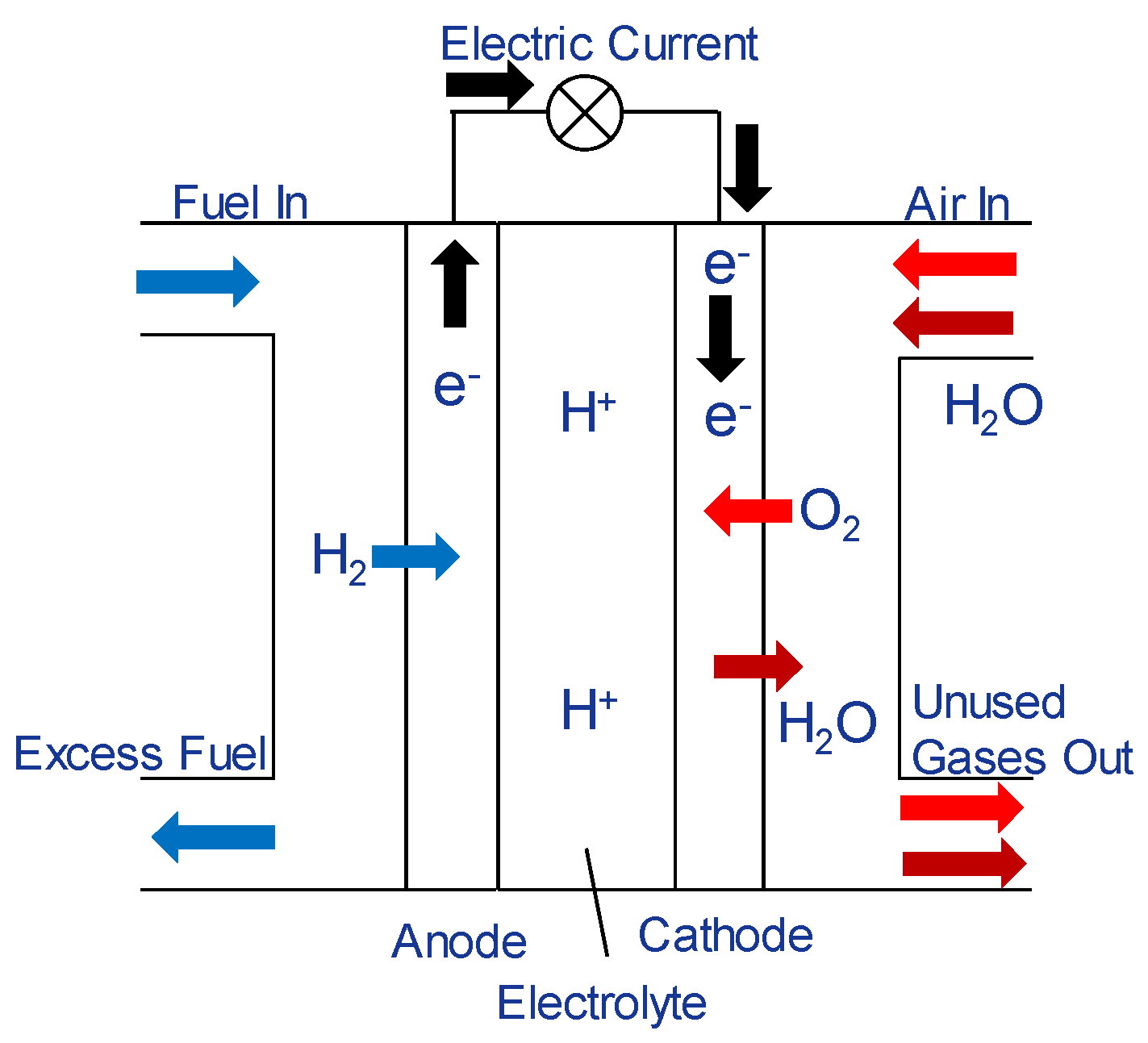


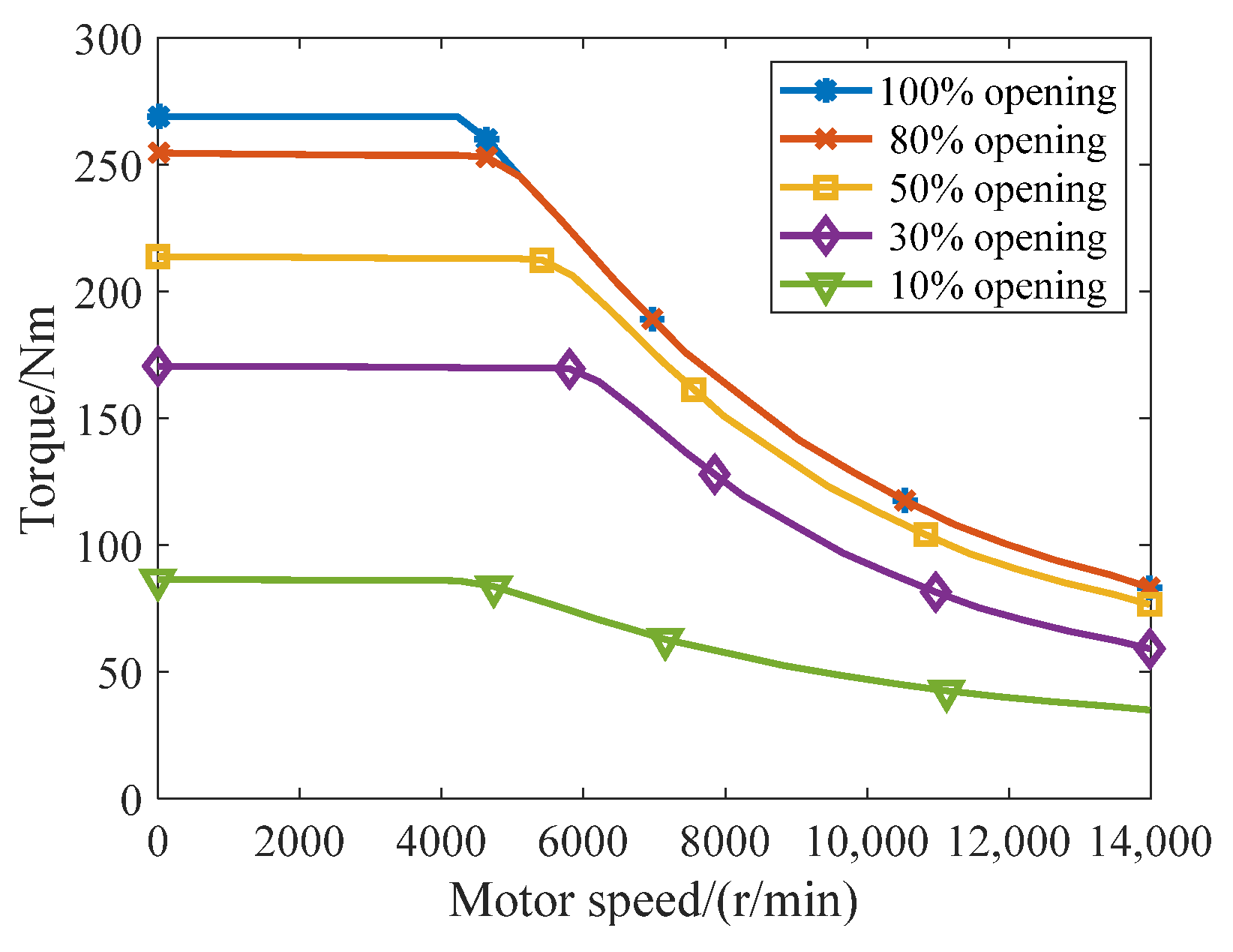
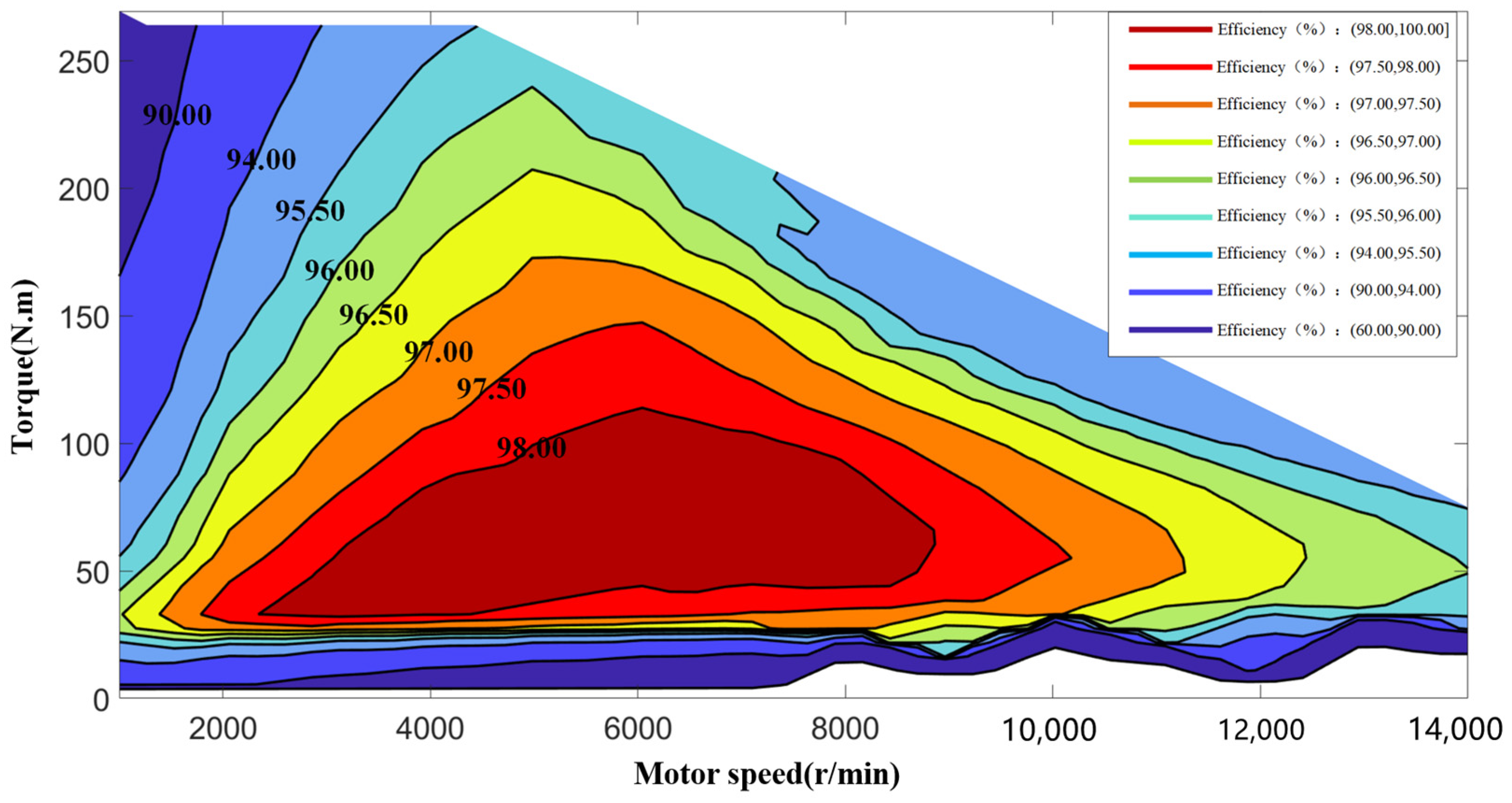
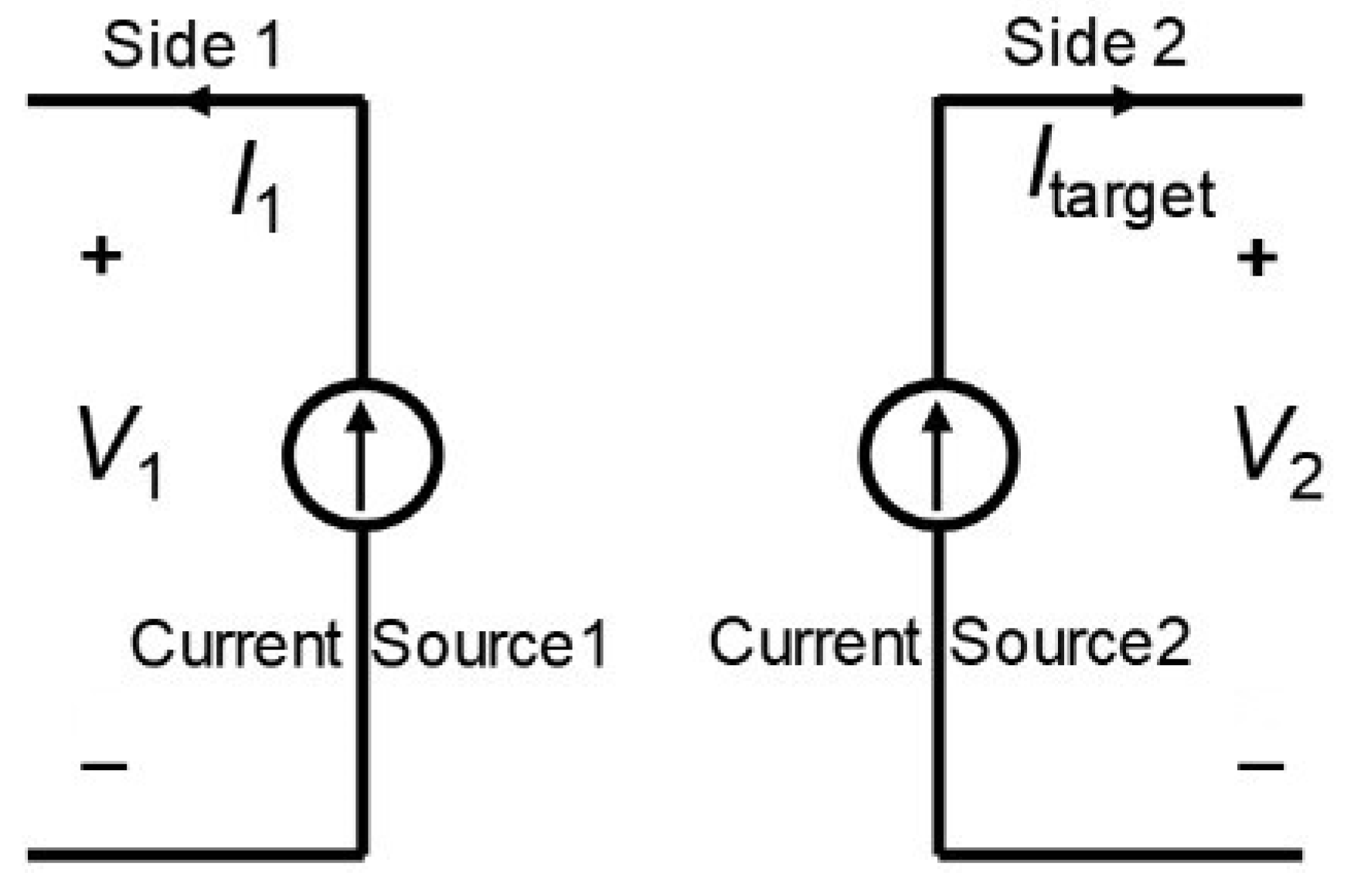
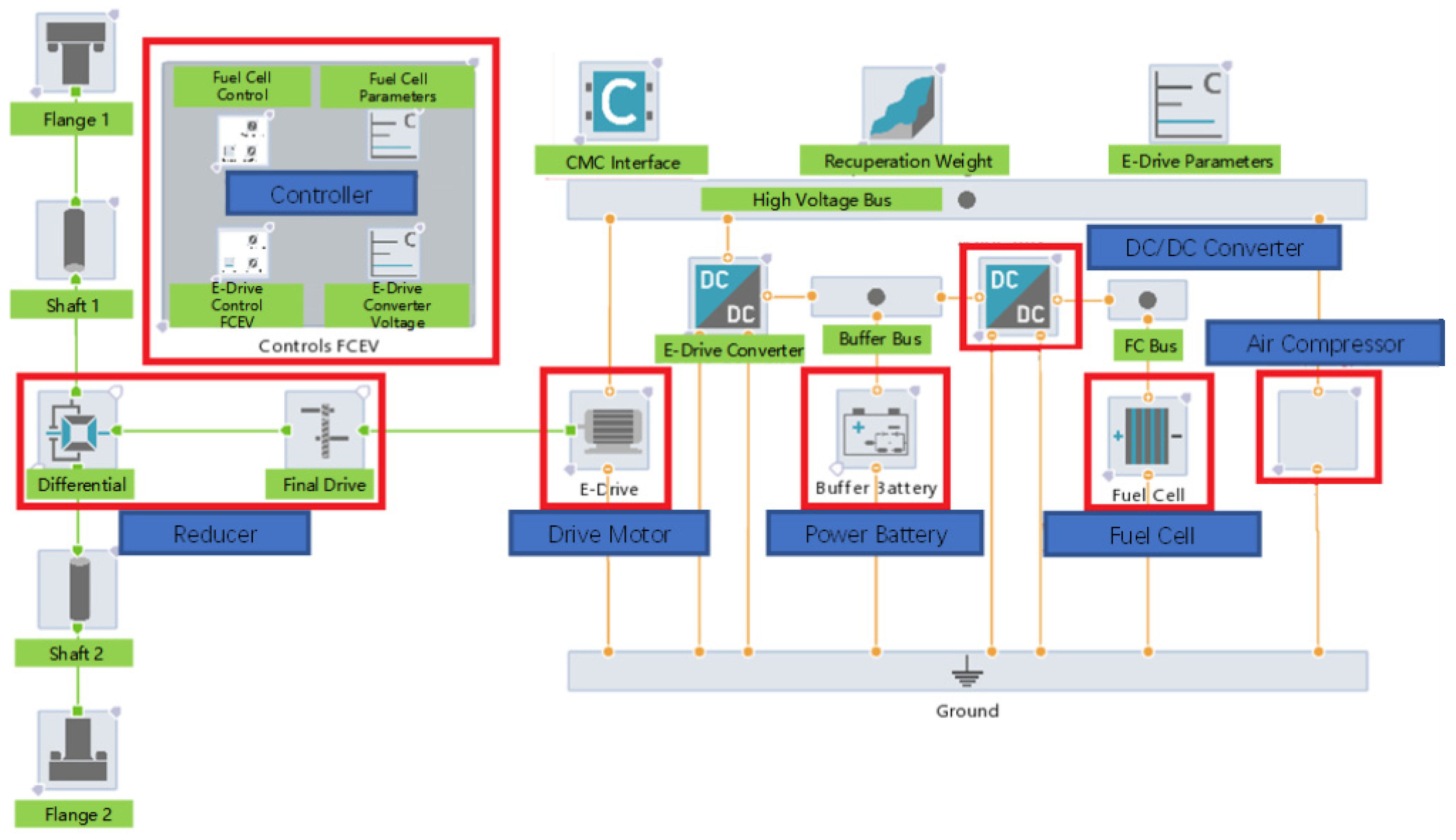

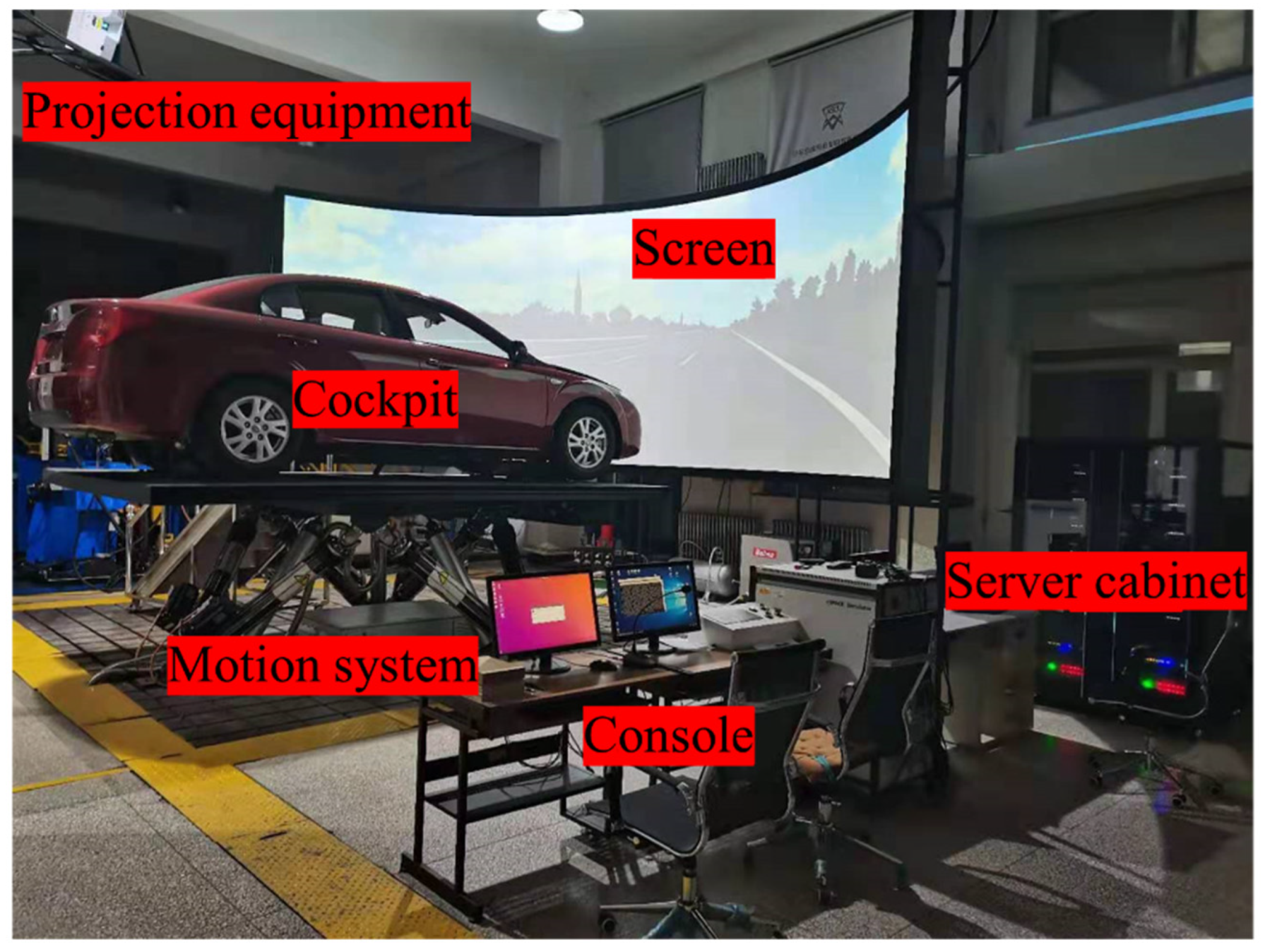
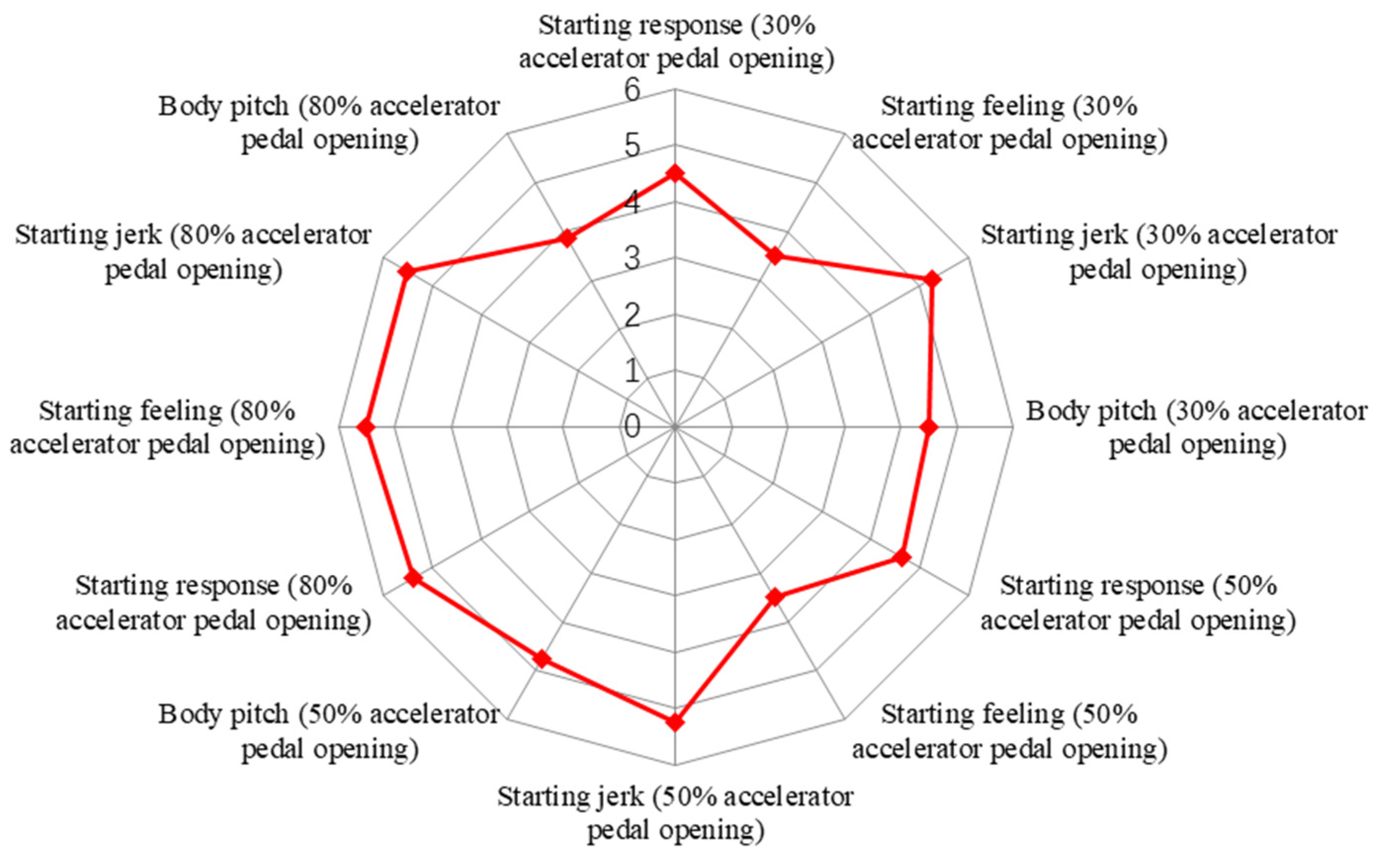
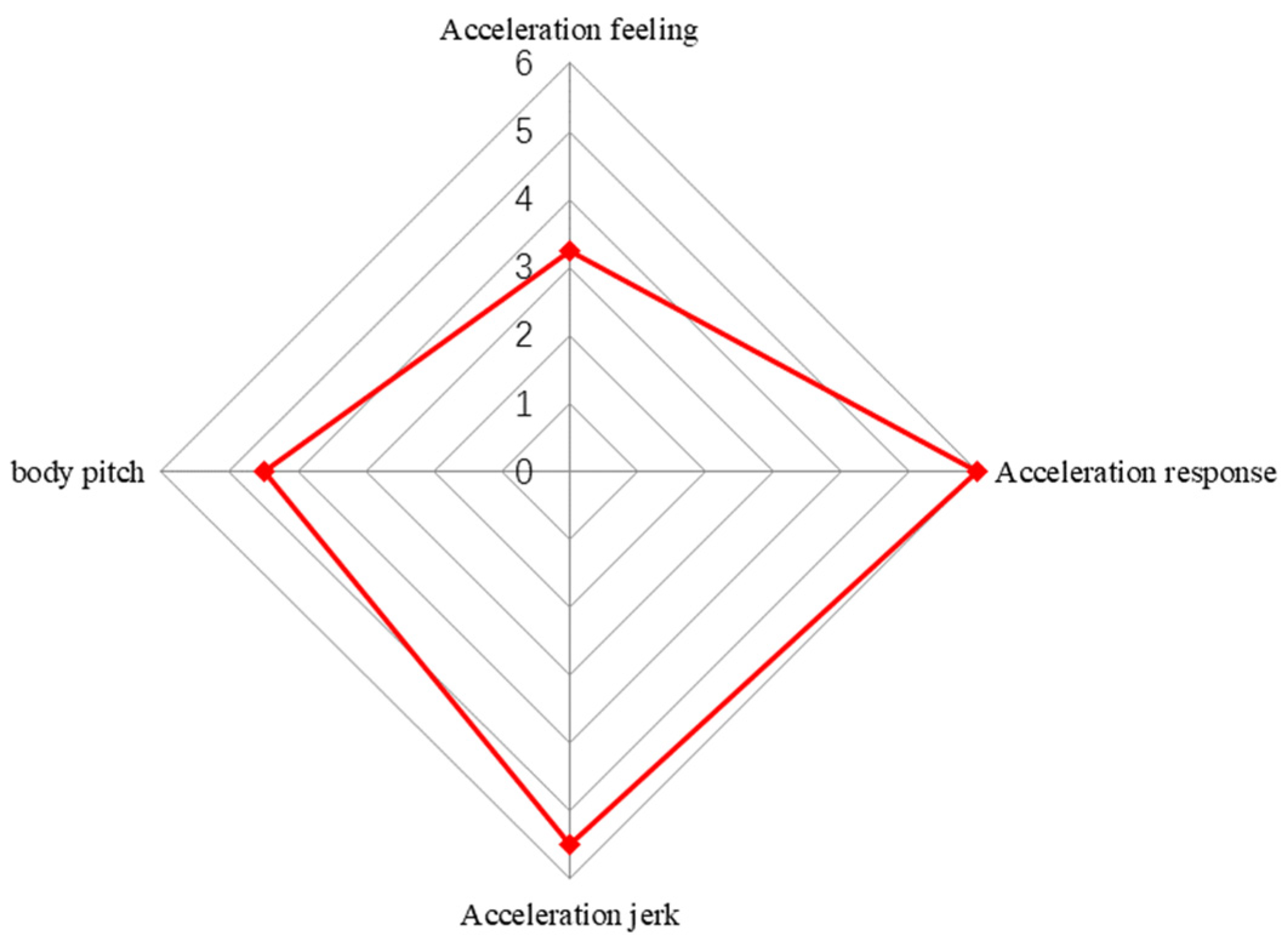
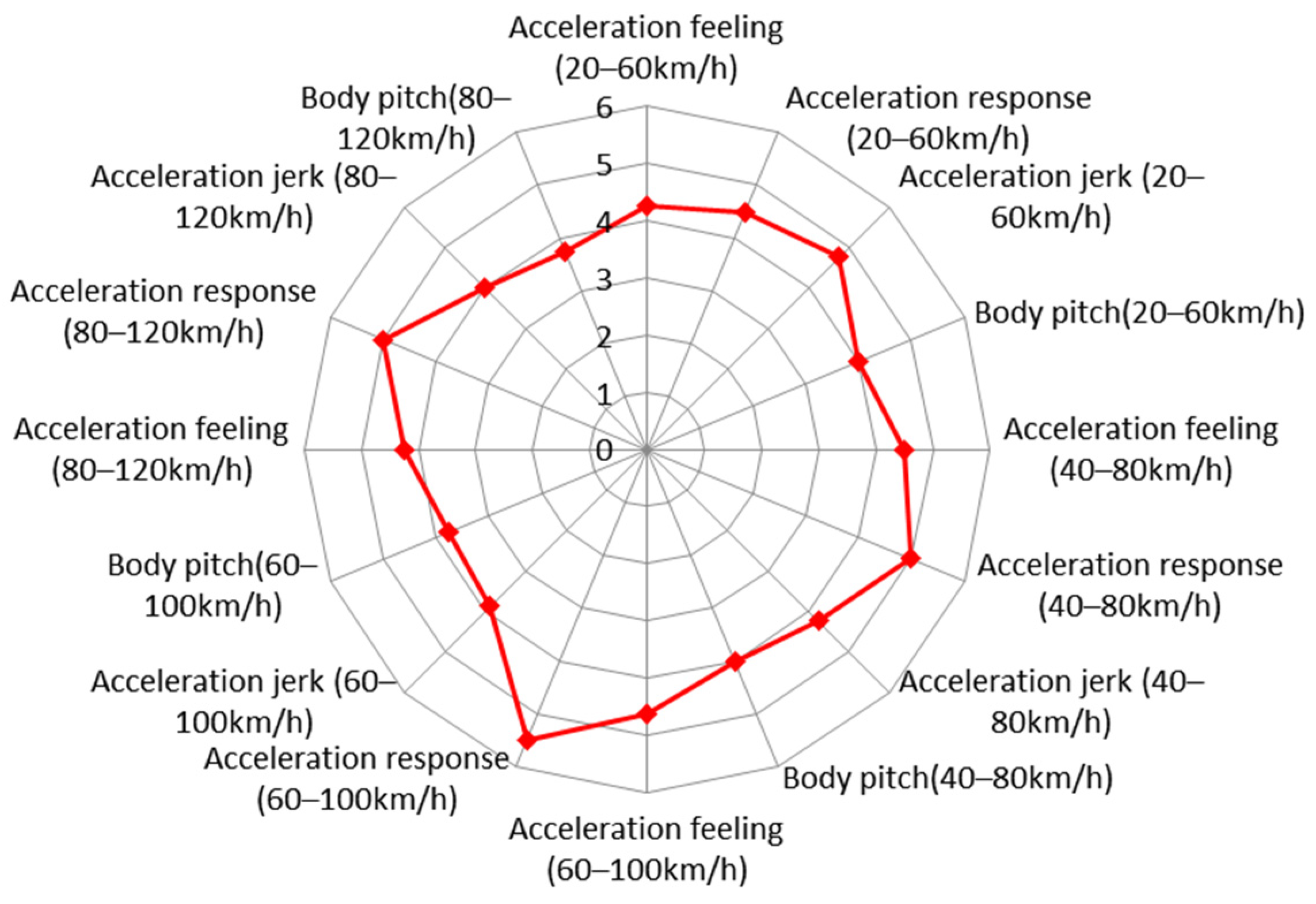
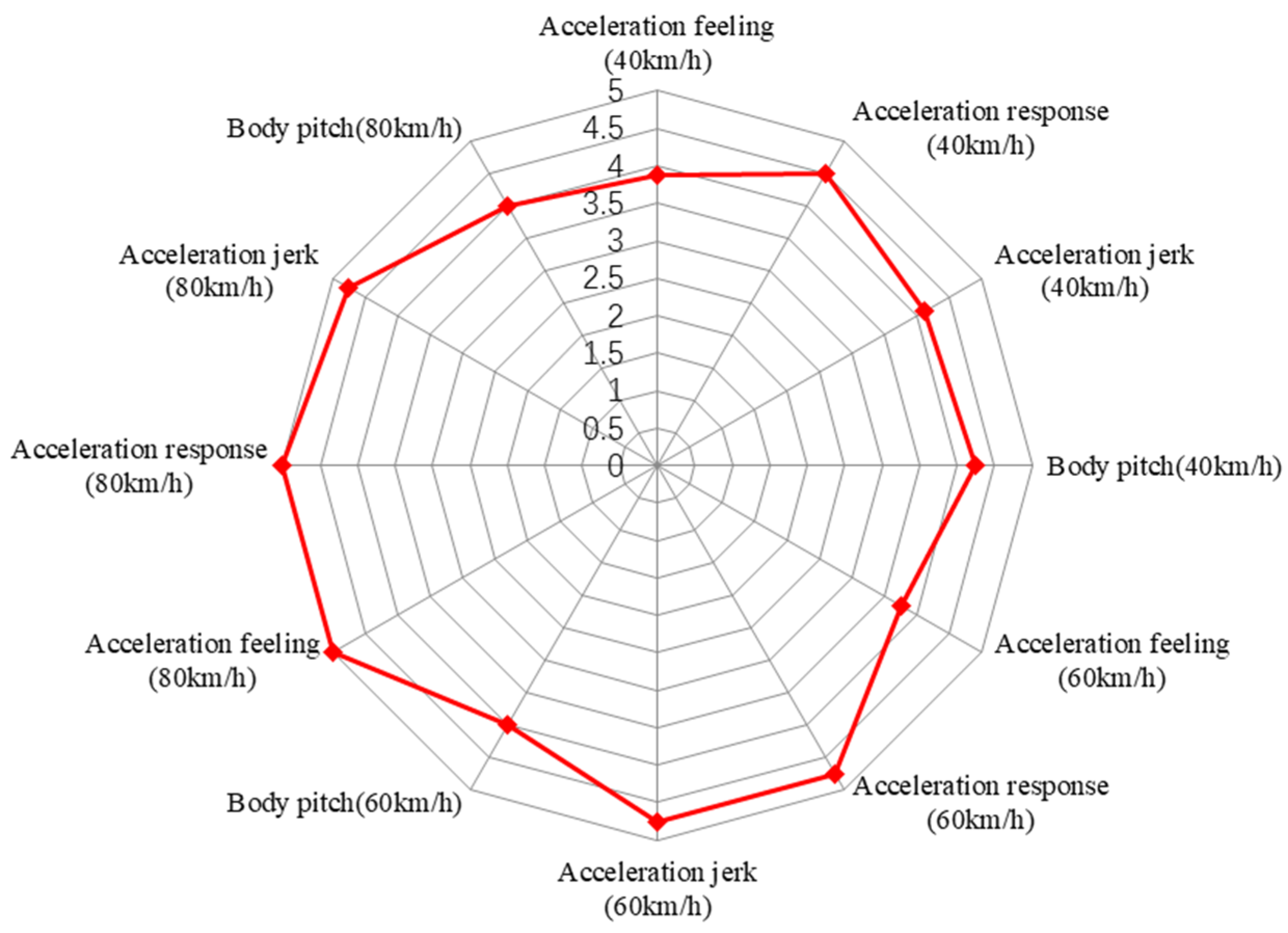
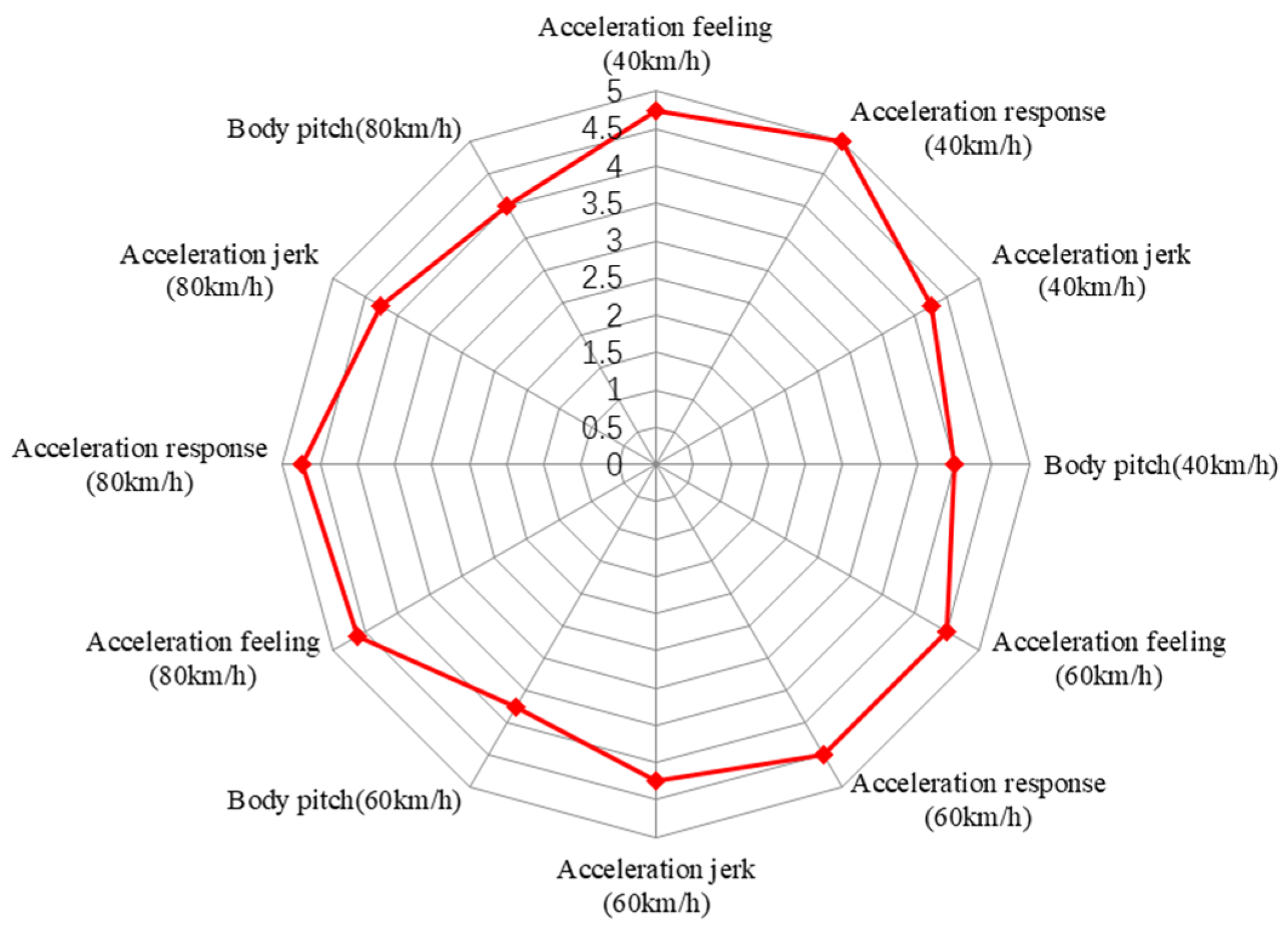


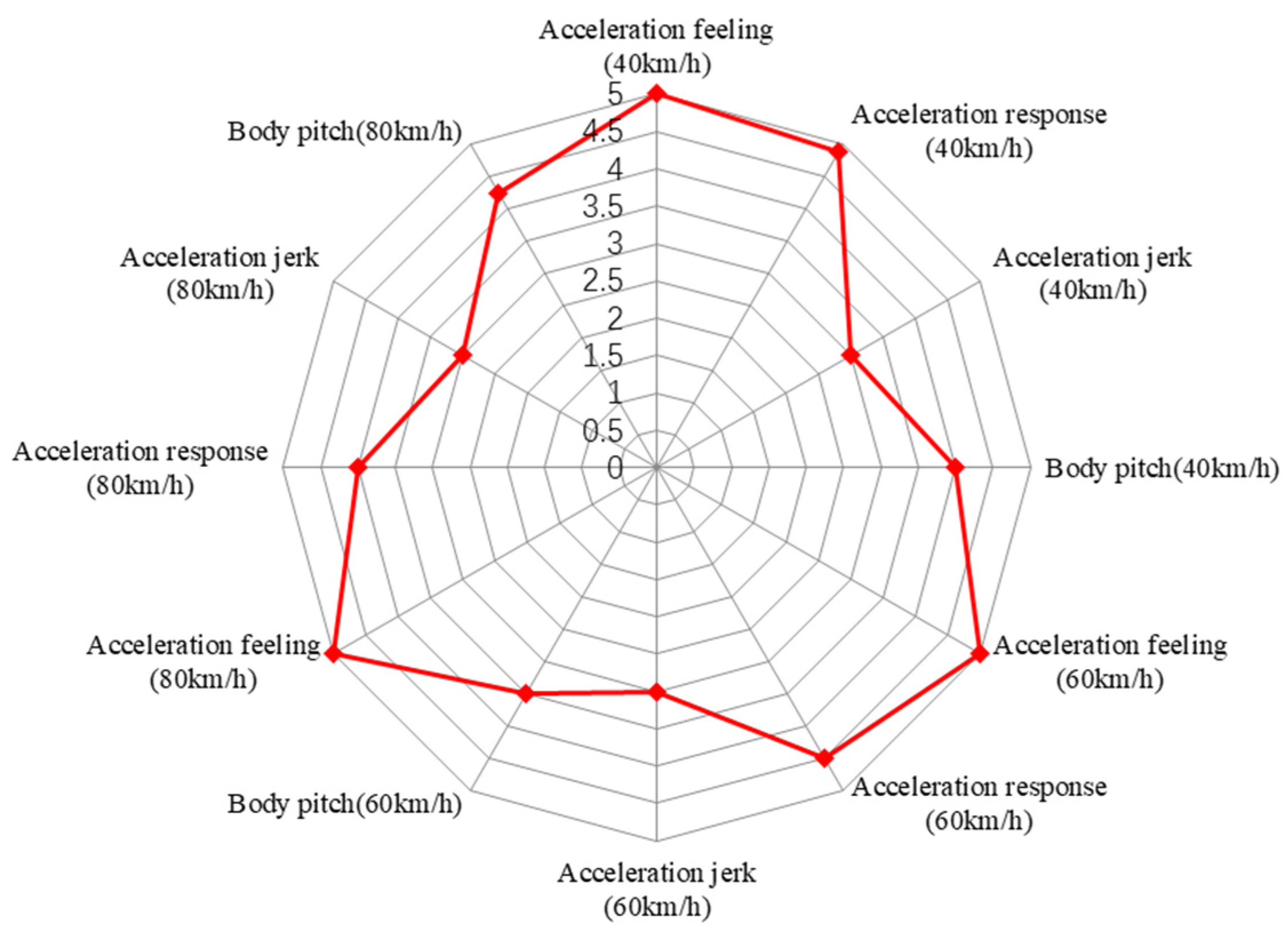

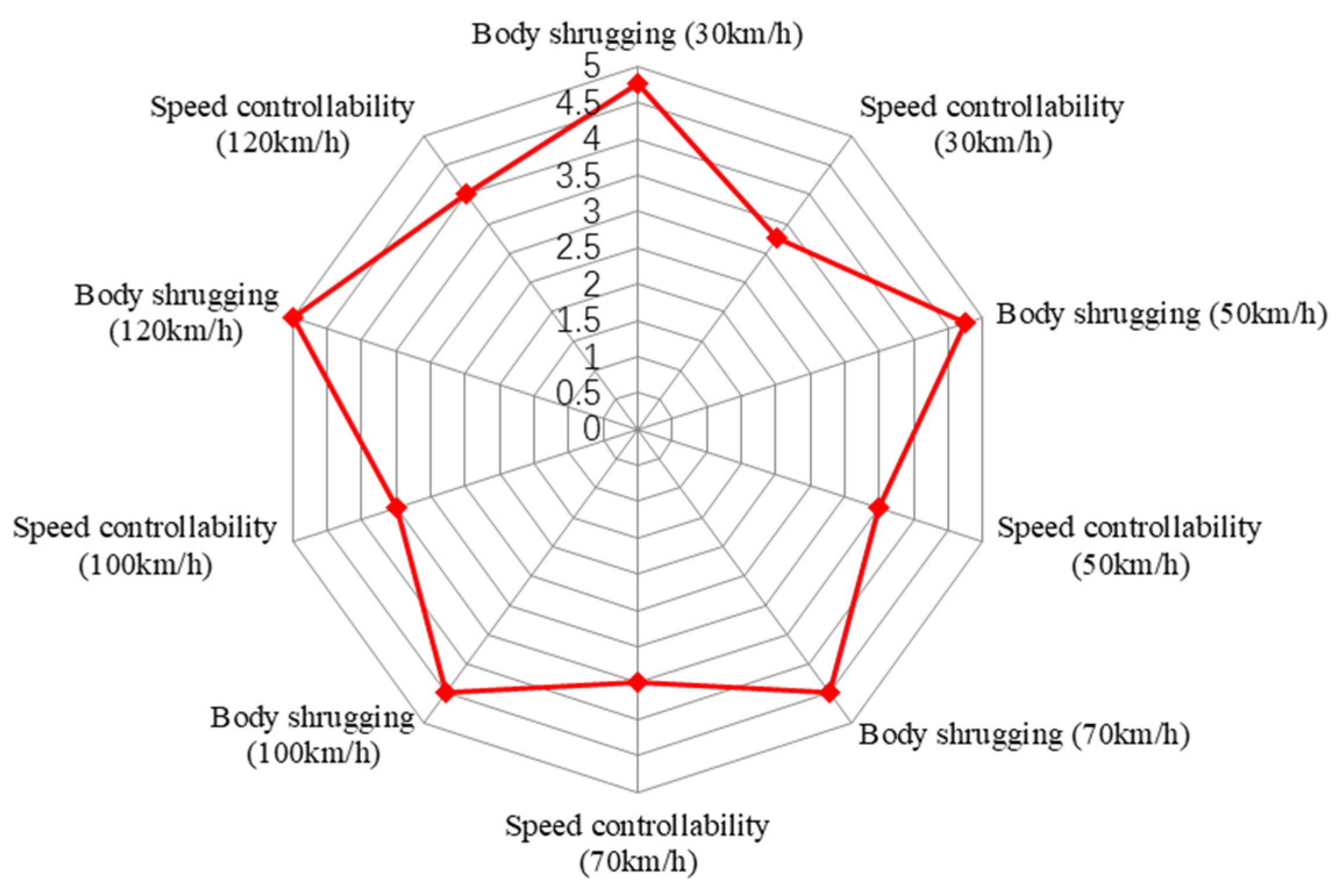
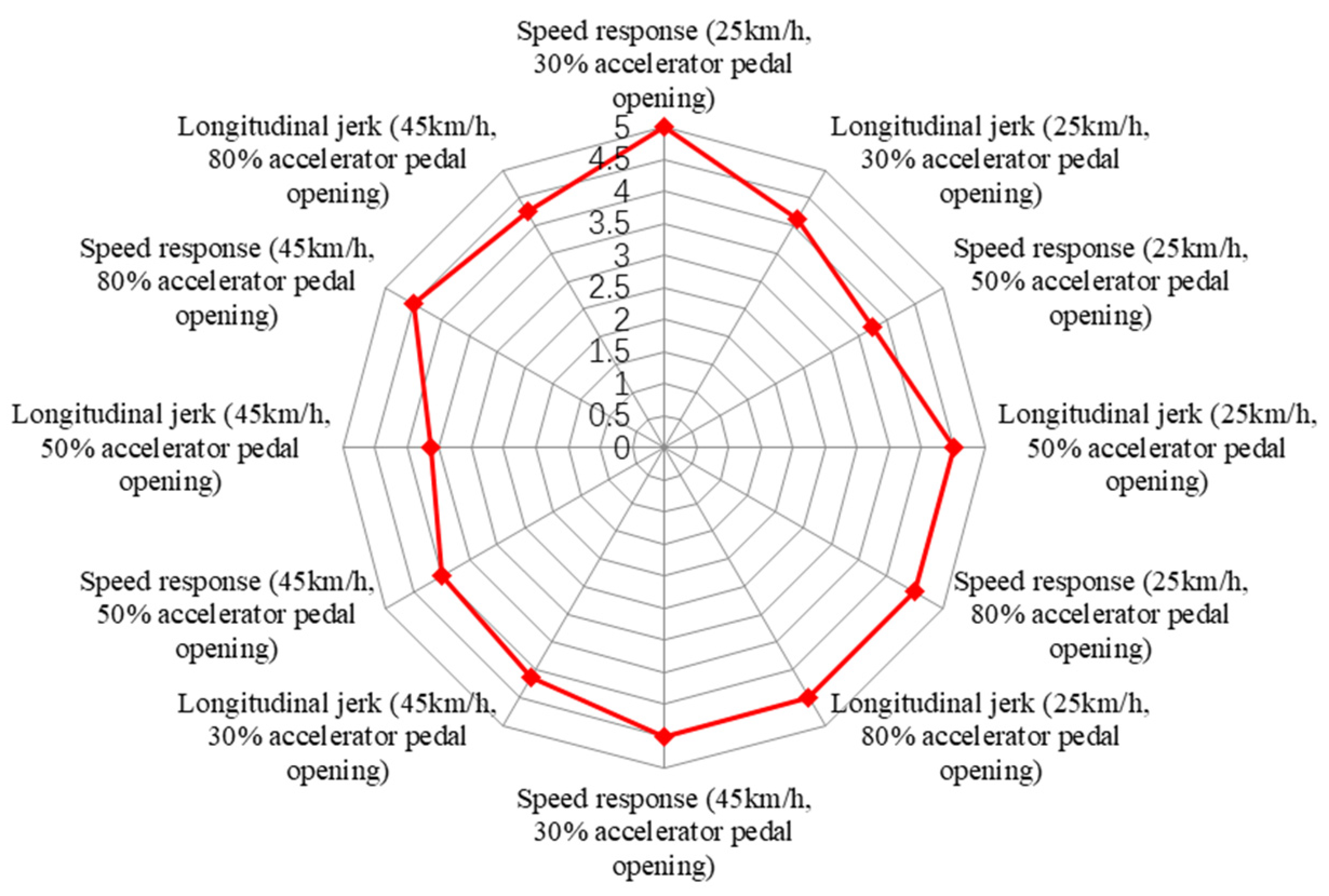
| Scores | 1 | 2 | 3 | 4 | 5 | 6 | 7 |
|---|---|---|---|---|---|---|---|
| Descriptions | Severe | Very poor | Poor | Fair | Good | Very good | Excellent |
Disclaimer/Publisher’s Note: The statements, opinions and data contained in all publications are solely those of the individual author(s) and contributor(s) and not of MDPI and/or the editor(s). MDPI and/or the editor(s) disclaim responsibility for any injury to people or property resulting from any ideas, methods, instructions or products referred to in the content. |
© 2024 by the authors. Licensee MDPI, Basel, Switzerland. This article is an open access article distributed under the terms and conditions of the Creative Commons Attribution (CC BY) license (https://creativecommons.org/licenses/by/4.0/).
Share and Cite
Zhan, J.; Zhu, H.; Duan, C.; Zhong, Z.-H.; Huang, W.; Zhu, B.; Xu, G. Modeling and Subjective Evaluation Method of Driveability for Fuel Cell Vehicles. Energies 2024, 17, 1620. https://doi.org/10.3390/en17071620
Zhan J, Zhu H, Duan C, Zhong Z-H, Huang W, Zhu B, Xu G. Modeling and Subjective Evaluation Method of Driveability for Fuel Cell Vehicles. Energies. 2024; 17(7):1620. https://doi.org/10.3390/en17071620
Chicago/Turabian StyleZhan, Jun, Huainan Zhu, Chunguang Duan, Zhao-Hui Zhong, Wei Huang, Baoli Zhu, and Guangjian Xu. 2024. "Modeling and Subjective Evaluation Method of Driveability for Fuel Cell Vehicles" Energies 17, no. 7: 1620. https://doi.org/10.3390/en17071620
APA StyleZhan, J., Zhu, H., Duan, C., Zhong, Z.-H., Huang, W., Zhu, B., & Xu, G. (2024). Modeling and Subjective Evaluation Method of Driveability for Fuel Cell Vehicles. Energies, 17(7), 1620. https://doi.org/10.3390/en17071620





